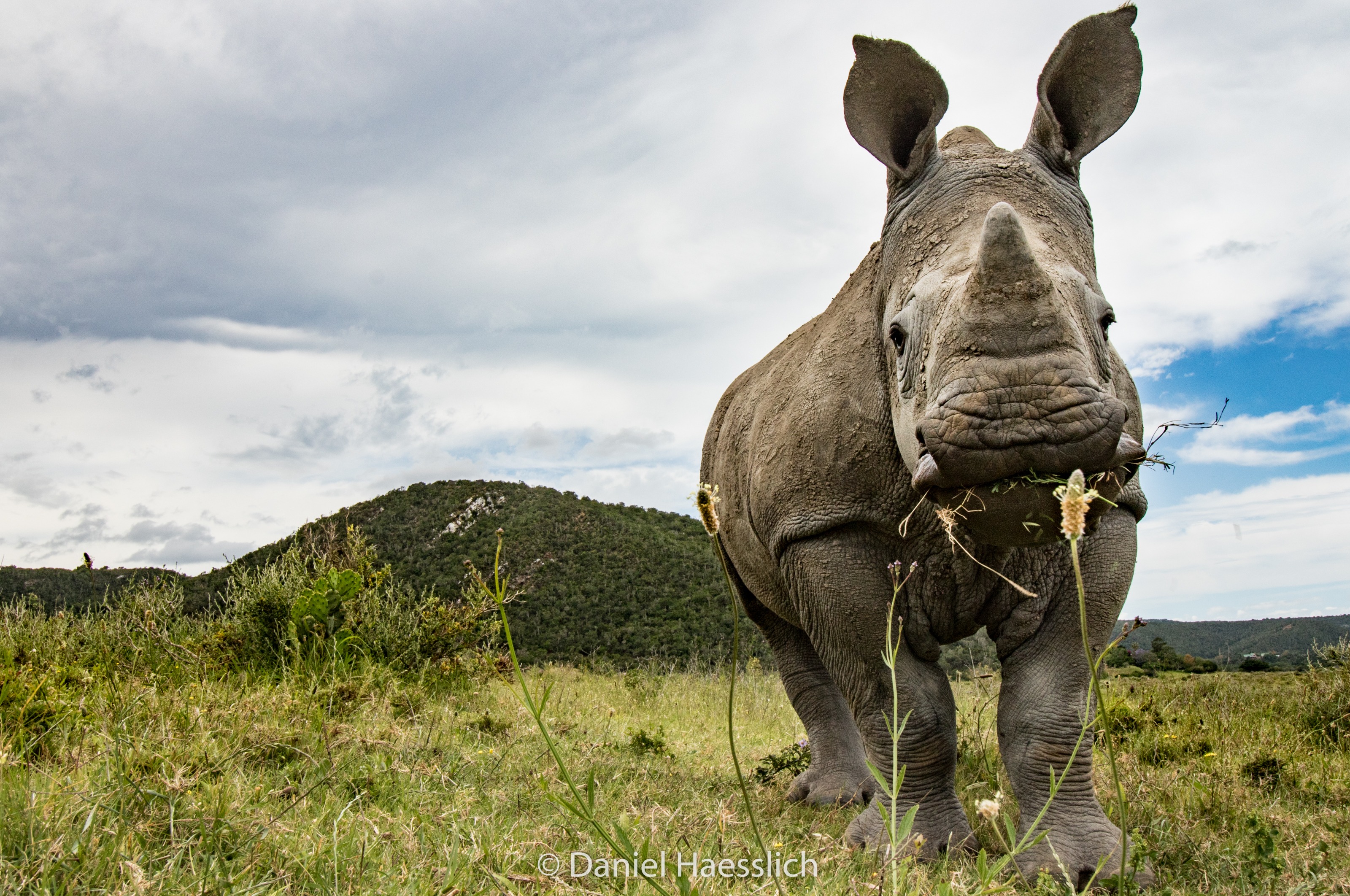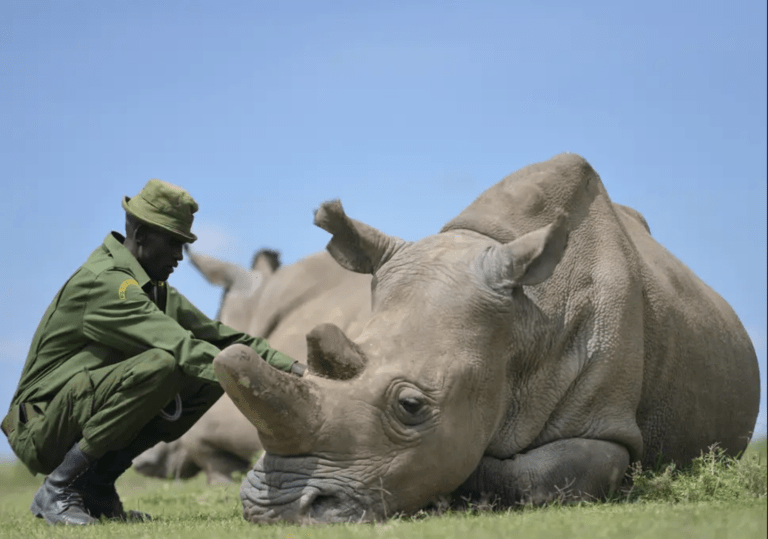The rhino crisis

Source - Helping Rhinos 2019 (www.helpingrhinos.org/)
Rhinos are a critically endangered species. There are less than 30,000 rhinos living in the wild today. At the start of the 20th century, there were over 500,000.
The western black rhino was declared extinct in 2011 and now the northern white rhino seems to be heading towards the same tragic fate. In March 2018, Sudan the last male northern white rhino was put down, highlighting the huge extinction crisis across the globe.
Human activity has caused this dramatic decline in rhino numbers. Initially numbers dropped due to hunting, but today the main threats to rhino are poaching, habitat loss and climate change.
Poaching
9,300% is the increase in rhino poaching incidents in South Africa over the past 8 years. On average 2 rhinos are poached every day - only 1 in 100 will survive such an attack.
Habitat loss & climate change
Both Asian and African rhinos are constantly under serious threat due to the loss of their forest, grassland and marshland habitat – mainly due to human settlements, logging and expanding agriculture.
Illegal wildlife trade
The recent surge in rhino poaching is to fuel the increasing demand for rhino horn in Vietnam especially, where it's seen as a symbol of status and wealth.

This is Fatu - one of the last two Northern white rhinos left on this planet.
The Current State of African Rhinoceros Populations: A Conservation Success Story with Ongoing Challenges
The African rhinoceros, comprising two species—the black rhinoceros (*Diceros bicornis*) and the white rhinoceros (*Ceratotherium simum*)—is one of the most iconic yet imperiled creatures on the continent. These majestic animals, with their characteristic horns and massive size, have faced significant challenges for decades due to poaching, habitat loss, and human-wildlife conflict. Yet, recent conservation efforts have shown signs of success, although serious threats remain.
Overview of the African Rhinoceros Species
- White Rhinoceros: The white rhinoceros is the larger of the two species and is divided into two subspecies: the southern white rhinoceros and the northern white rhinoceros. While the southern subspecies has experienced a remarkable recovery thanks to conservation efforts, the northern white rhinoceros is on the brink of extinction, with only two individuals left in captivity, both females.
- Black Rhinoceros: The black rhinoceros is critically endangered, with a much smaller population compared to the white rhino. However, concerted conservation efforts have slowed the dramatic decline seen in the latter half of the 20th century, leading to gradual population growth.
Population Status and Conservation Efforts
The populations of both species have fluctuated over the years (As of 2023):
- White Rhinoceros: The southern white rhinoceros, once close to extinction in the early 1900s, now numbers around 16,000 individuals. This success story is often credited to the protection efforts in South Africa’s Kruger National Park and private game reserves. However, ongoing poaching continues to threaten this fragile recovery.
- Black Rhinoceros: The black rhino population, although critically endangered, has been increasing slowly over the last few decades. From a population low of around 2,300 in the 1990s, there are now approximately 5,500 individuals, with populations in Namibia, South Africa, Kenya, and Zimbabwe playing pivotal roles in their recovery.
Poaching: The Primary Threat
Despite these successes, both species remain under significant threat from poaching, which is driven by the demand for rhino horn, particularly in parts of Asia where it is valued for its supposed medicinal properties. Rhino horn, composed of keratin—the same material as human nails and hair—has no proven medical benefits, yet the demand continues unabated, often fueled by myths and traditional beliefs.
South Africa, home to the majority of Africa’s rhinoceros population, has borne the brunt of poaching activity. In recent years, there has been a slight decline in poaching incidents, thanks to increased anti-poaching efforts, technological advancements (such as drone surveillance), and international cooperation. However, the illegal trade remains highly lucrative, making it difficult to eradicate entirely.
Habitat Loss and Human-Wildlife Conflict
Beyond poaching, habitat loss due to human expansion, agriculture, and infrastructure development also poses a significant threat to the rhinoceros. Expanding human populations and land use have reduced available habitats, particularly for black rhinoceroses, which rely on more specific environments.
Human-wildlife conflict is another growing issue. As rhinos are displaced into smaller, isolated patches of habitat, interactions between humans and rhinos increase, often resulting in damage to crops and infrastructure, which can lead to retaliatory killings.
Conservation Successes and Strategies
Efforts to conserve African rhinoceroses have been multi-faceted and have achieved some notable successes:
1. Protected Areas and Reserves: The creation of protected areas, such as national parks and private game reserves, has been crucial to rhinoceros conservation. Countries like South Africa, Namibia, Kenya, and Zimbabwe have invested heavily in wildlife protection, often relying on tourism as a financial incentive to maintain these protected areas.
2. Anti-Poaching Initiatives: Ranger patrols, technological tools like drones, and international collaborations have helped reduce poaching numbers in recent years. For example, dehorning programs—where rhinos are anesthetized, and their horns removed—are one temporary measure to deter poachers.
3. Breeding Programs and Translocations: Relocation and breeding programs, especially for the black rhinoceros, have helped boost population numbers in safe areas. Moving rhinos from poaching hotspots to better-protected areas has allowed populations to stabilize and grow.
4. International Trade Bans and Legal Action: The international trade in rhino horn has been illegal under the Convention on International Trade in Endangered Species (CITES) since 1977, but illegal trade persists. Efforts to strengthen laws and improve enforcement have been critical, though there is growing debate about whether a legal, regulated trade could help protect rhinos.
The Role of Local Communities
Empowering local communities in conservation efforts has proven to be a key factor in successful rhino conservation. In places like Namibia, community-based conservancies allow local populations to benefit economically from wildlife, creating incentives to protect animals rather than poach them. Eco-tourism plays a vital role here, providing jobs and income for communities while protecting rhinos.
Challenges Ahead
Despite encouraging signs, the future of African rhinos remains uncertain. The illegal demand for rhino horn continues, while the challenges posed by climate change, shrinking habitats, and political instability in some regions exacerbate the threat to their survival. Moreover, as rhinos are moved to smaller, fenced reserves, there is growing concern about genetic diversity and the long-term viability of isolated populations.
Conclusion
The story of the African rhinoceros is a mixture of hope and challenge. While the white rhinoceros has made a remarkable recovery, and black rhinos have started to rebound, both species remain vulnerable. Continued vigilance, international cooperation, and innovative conservation strategies are essential to ensure that future generations will be able to witness these magnificent animals in the wild.
Through sustained efforts, it is possible that Africa’s rhinos can avoid extinction, but success will depend on addressing both the immediate threat of poaching and the broader issues of habitat preservation and human-wildlife coexistence.

